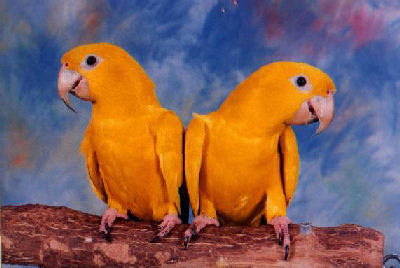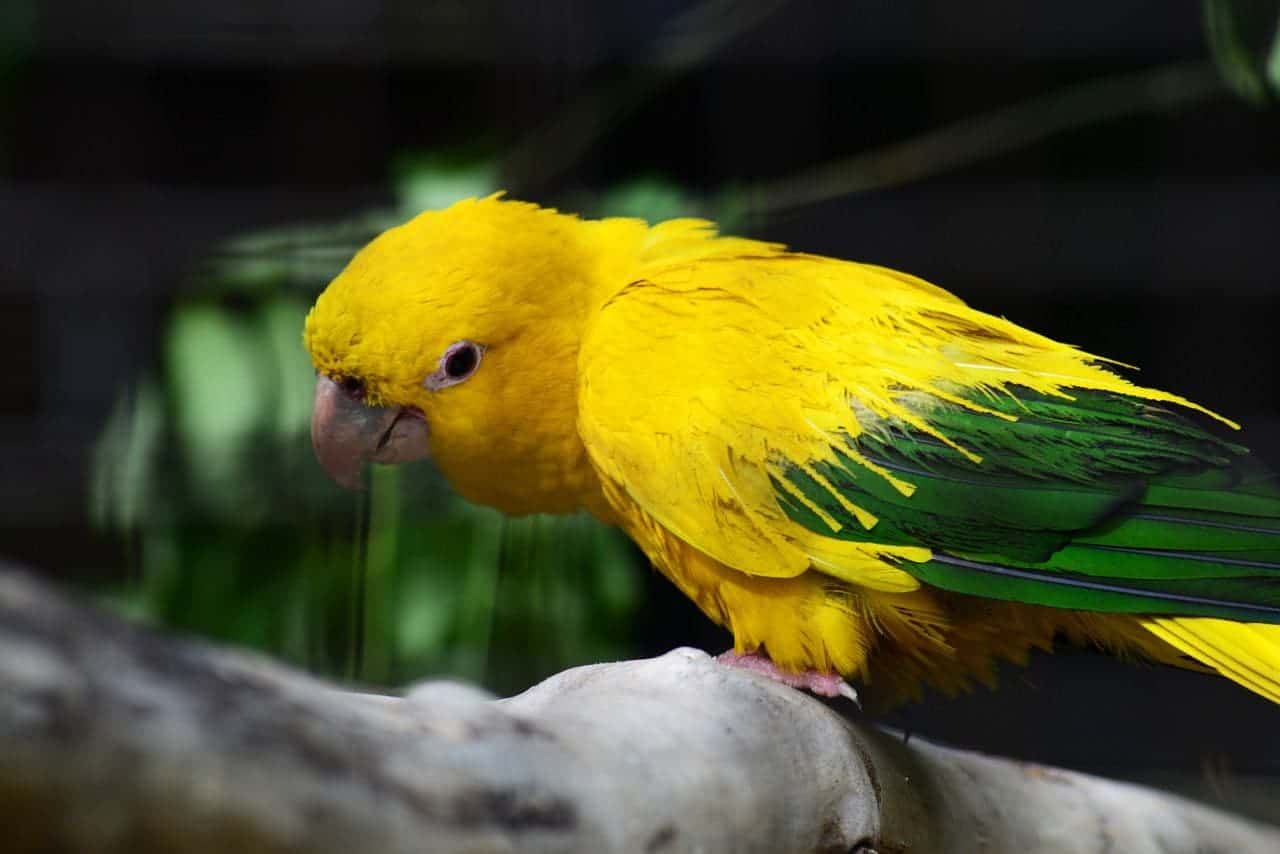The Queen of Bavaria or Golden Conure is the most beautiful and most sought after of all the conures!

A very rare and highly endangered species, the Queen of Bavaria Conure also known as the Golden Conure is protected against collection and importation, as well as being closely regulated in the United States. It is also very expensive.
The Queen of Bavaria Conure does makes a spectacular pet that is very beautiful and affectionate. Being quite intelligent makes them easy to tame and train. They can be good talkers, but like many of the Aratinga conures they can also be very loud.
The Queen of Bavaria Conures or Golden Conures are very lively little birds, though in captivity they will rarely fly. Rather they choose to climb about, perform acrobatic maneuvers, and be quite comical. Human companionship is greatly enjoyed and they can be very affectionate. A favorite activity is to chew, so be sure to provide lots of wooden toys to keep them from becoming bored.
This conure does have one bad habit, they are prone to feather plucking, especially the wings and chest. This is possibly due to their high energy needs, and becoming bored in a limited space without enough activity or stimulation. It is recommended that you give them plenty of toys and freedom of movement, as well as plenty of proteins, calcium, and mineral supplements.
Dr. Jungles says,…Wow! “Boots” and Bottoms” are celebrities! “My Queens, “Boots” and “Bottoms”, became “famous” doing a Hagen ad!” “The Queens are called the Queens of Bavaria, sometimes the Golden Parrot. They really DNA wise do not completely belong to any family but are closest to the conure. They are nutty, playful, love fun, sliding down pillows on the sofa, hang from curtains, are very affectionate and I never found them to be at all aggressive, even when on eggs! |
For more information about the care of Conures see:
Guide to a Happy, Healthy Conure
- Kingdom: Animalia
- Phylum: Chordata
- Class: Aves
- Order: Psittaciformes
- Family: Psittacidae
- Genus: Aratinga
- Species: guarouba
Scientific Name:
Aratinga guarouba
(recently renamed to: Guaruba guarouba)
Distribution:
The Queen of Bavaria Conure or Golden Conure is found in a remote area of northeastern Brazil. They have long been known to naturalists. A Dr. Greene is said to have described this bird as the Golden Parrot in a writing in 1887, and he advises that there was a specimen in the London Zoo since 1871. They were first bred in Sri Lanka in 1939, and in the United States in 1945.
Due to the destruction of thousands of acres of jungle, their native habitat has been drastically reduced. Today they are extremely rare and are protected. Even in captivity there are limited numbers and their status is very fragile. Keeping them in captive breeding programs has taken precedence hopefully with the aim of precluding any further need to collect them from the wild.
Description:
The Queen of Bavaria Conure or Golden Conure, a small member of the parrot family, is considered the most beautiful of the conures. They are a brilliant golden yellow with only the lower portion of the wings being green. They rather resemble a small macaw with a beak and head that is quite large, though they have a relatively short tail. The eye is brown surrounded by a naked white eye ring. The beak is a pale horn color and the legs are a light pink.
The young have green feathers in the plumage and the yellow is duller. They are fully feathered by 18 months of age.
Size – Weight:
The Queen of Bavaria Conure or Golden Conure will reach up to 14 inches (35.5 cm) and weigh 8.8 ozs (249 g).
Care and feeding:
A roomy cage is required unless the bird is to be let out for extended periods. Many birds can spend most of their time on a play pen or parrot perch. They eat a variety of sprouts, seeds, nuts, fruits, vegetables, and commercial pellets, as well as the same nutritional foods humans eat.
See About Conures: Housing and About Conures: Care and Feeding for more information.
Social Behaviors:
In the wild they were at one time seen in pairs or small groups of up to about 60 birds, though today fewer birds are seen. They love to play, especially climbing and chewing. They can also be rather noisy.
Breeding/Reproduction:
They breed readily in captivity and are not overly fussy about their nest, though they get quite aggressive to their keeper while breeding. If they lose their mate they are unlikely to pair with another.
The female lays 3 to 4 eggs which are incubated for about 25 days. The young fledge (leave the nest) after about 10 weeks though the parents continue to feed them for some time after that.
Potential Problems:
As with most Aratinga species, this bird can be noisy.
See About Conures: Potential Problems for information on illnesses.
Availability:
The Queen of Bavaria Conure or Golden Conure is not readily available as a pet, and is quite expensive. They cannot be sold between state lines in the United States unless both the buyer and the seller obtain a permit from the U.S. Fish and Wildlife Service.
Activities:
Loves to climb and play. Provide lots of toys.
Featured Image Credit: Needpix
